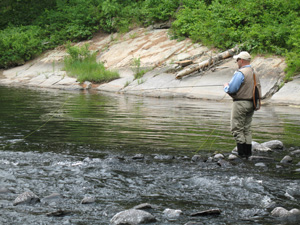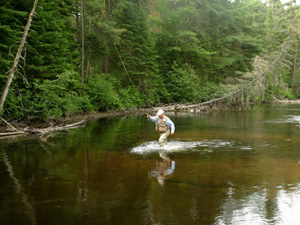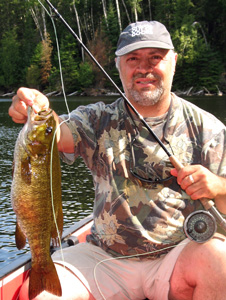
 Every new fly angler progresses through a learning curve. First, they acquire the gear; then they learn how to use it – often under the tutelage of a well-meaning mentor.
Every new fly angler progresses through a learning curve. First, they acquire the gear; then they learn how to use it – often under the tutelage of a well-meaning mentor.
Typically, we teach them the basics. We help them master overhead and roll casts and show them appropriate fishing techniques for the water and species. We then impart our thoughts on how to read water as well as teaching them a little about dry, wet, nymph and streamer flies.
Certainly, these things are essential. But it's my belief that we should also let new anglers in on just a wee bit more.
Loop-to-Loop Connections
Every guide I've ever had the pleasure of fishing with has encouraged loop-to-loop connections from fly line to leader. Many use this connection from leader to tippet too. There's good reason for this.
First, it allows you to change leaders and tippets very quickly so that you can react to what the fishing situation dictates. Second, if you opt for a loop-to-loop connection from leader to tippet, your expensive leader will last much longer since you will not be shortening it every time you tie on a new tippet.
Braided loop connectors are commercially available for your fly line, and some leaders come pre-tied with loops on the butt end. You can also tie loops in the line, leader and tippet by yourself. On leaders and tippets, I use the perfection loop; on the fly line, I double the line over and secure the tag end to the main line with a tube or nail knot. Then I glue the knot with super-glue.
After that it's a simple matter of joining everything with a loop-to-loop connection. This is done by placing the butt-end leader loop through the fly line loop and then threading the tippet end of the leader through the butt end leader loop and pulling tight. The tippet is attached similarly.
Initially, this preparation is a bit of work, but on the water it will allow you to spend more time fishing – a worthwhile trade if you ask me.
Threading Line
If you've ever let go of your fly line while threading it through the rod guides, you'll appreciate this next tip. Simply put, form a bight in the fly line (doubling up the end) and then thread it through the guides. That way, if you accidentally let go of the line, it will not fall back through all the eyes. Again, this is nothing radical, but it saves you frustration when rigging up.
Polarized Glasses
Want to catch more fish? Buy a quality set of polarized fishing glasses. They'll help you read the water, observe how your fly is working, spot fish and detect strikes. They'll also reduce eye strain and help protect you from errant hooks. Once you use a good pair, you'll never fish without them again.
 |
| If you don't have to wade, don't — unnecessary wading can spook fish. |
The Fish are in the Water
Many new fly anglers become so enamoured with the joy of casting that they seem to forget that the fish are in the water. But the truth is you only catch fish when your fly is in or on the water. While we're at it, it's quite fine to troll a fly in lakes too.
Cast all you like, enjoy the art and skill of it, but remember, casting is only a means to place the fly where the fish are. Once you get the fly there, that's when the real fun starts.
Rod Low
Except when high-stick nymphing or when faced with a few other unique situations, an angler should keep his rod tip low when fishing a fly. With rod tip at the water, the angler can keep in touch with the fly and easily raise his rod and tug down on line when a fish strikes. On the other hand, if your rod is held high, your only option is tugging line and moving the rod tip behind you, which is awkward and often ineffective.
Wade Only When You Have To
Waders are essential kit when fishing a stream or river, but never forget that any time you wade, you run the risk of spooking fish. Therefore, whenever the situation allows, your first effort should be to ease into a casting position on shore so you don't have to disturb water. When doing this step softly, keep low and try not to throw a shadow across the water.
Fly Rods are Good for More Than Just Trout
Fly anglers are definitely becoming more open-minded, but there's still a lingering perception that freshwater fly fishing is limited to just trout. That's just wrong. Pike, bass, carp, panfish and muskie are just some of the exciting options available -- each provides excellent sport and has its own appeal. You owe it to yourself to give them a try.
Fly Fishing Isn't Just a River Sport
Once again, this is all about broadening your perspectives. I've known too many new fly anglers who actually thought they'd look silly using a fly rod while lake fishing. For some reason, they were convinced that the only proper way to fly fish was in moving water. Again, nothing could be further from the truth. Lake fishing provides a great alternative to crowded rivers and takes a different skill set.
Most times a floating line will do the trick, but depending on the situation you might have to switch to various types of sinking lines to get the fly down to where the fish are. Like every other form of fly fishing, you just need to match the gear to the application. This means you need to consider the wind, the type of flies used, the depth you need to fish at, and the target species.
A Few Good Knots
The worst place to learn a fishing knot is on the water while a hot bite is on. It's far better to learn these things while you're home relaxing with an instructional book, video or diagram in hand. Mastering fishing knots takes concentration and a lot of repetition – it needs to be second nature.
 |
| Bass, pike, carp, panfish and muskie are just some of the other options available to fly anglers. |
Learn a few good ones well and use them for intended situations. Personally, I'd recommend the Perfection Loop, Clinch Knot, Duncan's knot, Double Surgeon's knot, Blood knot and Tube knot, but the more knot lore you have, the better.
Yes, it's not real exciting and it takes some effort, but the importance of it will be understood once you watch someone lose a trophy fish due to a poorly tied knot.
It's Better to Fish Close Than Far
While long casts are beautiful to watch and a joy to pull off, never forget that a lengthy line makes catching fish more difficult.
It's far better to fish a shorter length of line. This allows you to keep in better contact with your fly and manage your line better. The result is that you detect the bottom, weeds, logs and the subtle takes. Also it allows you to set the hook with more authority. Naturally, there are times when using a long line is the only option, but given the choice, it pays to get as close to the fish or structure as you can without spooking the water.
Conclusion
Hopefully, these tips will help flatten the learning curve just a bit more. Make use of all, or even some, and your fly-fishing experiences will be better. Heck, you might even catch more fish.
- 7310 views

